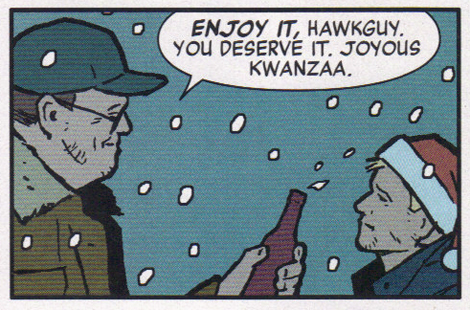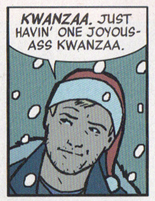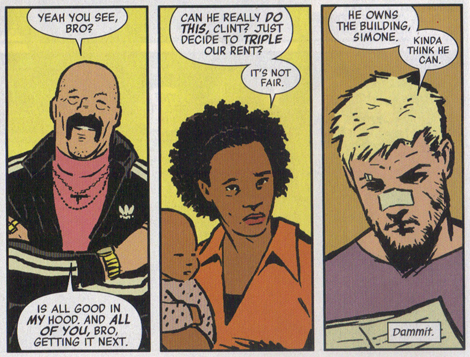 I’ve been thinking about the role of setting in Marvel’s latest Hawkeye series by Matt Fraction (and David Aja).
I’ve been thinking about the role of setting in Marvel’s latest Hawkeye series by Matt Fraction (and David Aja).
This series has been pretty highly regarded by both fans and critics. It is has been put on 10 Best Current Marvel title lists by both Multiversity and PASTE. The first trade collecting the first five issues gets nearly five stars over on Goodreads. There are countless examples of good reviews, but I won’t take the time to link them all here, as Das Racist would say, “If you don’t get it, get a computer and Google it.” If you are into superhero comics or gritty psuedo-noir crime comics (and don’t mind that it emerges from a superhero setting), I highly recommend reading Hawkeye if you haven’t. From the opening glass-shattering thrown through a window splash page to the quirky heartwarming relationship with his neighbor/tenant “Grills” (who calls him “Hawkguy”), the series has a lot of verve—great pacing, evocative art, and snappy Whedonesque patter.
But despite all this praise for a noteworthy series that I admittedly love and look forward to every issue—putting it on the bottom of my new comics pile as to make sure I save the best for last (well, Dial H is last, but you know my steeze)—only Colin Smith over at Too Busy Thinking About My Comics has brought up a glaring oversight in the series in his review of the first issue (Colin is articulate, erudite and always on point, so I am not surprised his critical eye caught this right out the gate).

“Most folk out here have other stuff on their minds–” (from Hawkeye #1, 2012)
Hawkeye takes place in Bed-Stuy (Yay! A superhero comic in Brooklyn!), but there are almost no black characters depicted! As Mr. Smith points out in his review of issue #1: “We’re shown 38 or so folks in its streets, tenements, gambling clubs and veterinarians, with only 7 of them being Black, and only 1 of those – a victim – having even a brief speaking role.” I went back and recounted. Yep, seven. . . and while three of them speak, only one (the victim) has more than one line of dialogue and a name. I even went through and checked the rest of the issues, since its been about nine months since the series started, and it only gets worse, not better. Sure, several of the issues don’t take place in Bed-Stuy at all, but they always start off and/or end up at the building Clint Barton ends up owning there (which he bought with money he steals from bad guys who robbed it from other bad guys). In fact, you have to wait until issue #6 to have a speaking black character again, Simone (the same woman from issue #1), which makes all the ironic wishing of “joyous Kwanzaa” between neighbors a bitter pill to swallow.

(from Hawkeye #6)
Here’s the thing, the setting of the Hawkeye comic is central to the series—or is supposed to be, should be. The way this Brooklyn neighborhood is depicted is meant to set it apart from the over-the-top superheroic world of Manhattan Island with its skyscrapers to be leapt over and ever in danger of being shot into orbit by Galactus’s herald like back in Fantastic Four #242. Clint Barton is seeking to escape the “mainstream” world of the Marvel Universe for something a little more down-to-Earth and edgy. Hawkeye’s lack of powers (save for his ability to shoot arrows, take a beating, and fuck up his love life) works in the gritty atmosphere depicted in Aja’s pencils and Hollingsworth’s colors. It it is world of working class folks dealing with slumlords and tracksuit mobsters, contentious relationships with their aging parents and sharing some beers on the roof in the evening—not the maleficent mischief of Loki, but of everyday life.
 But why choose Bed-Stuy as the setting if you are going to elide the fact that it is a predominantly and historically African-American neighborhood? Matt Fraction doesn’t have the excuse of ignorance. He may live on the west coast now, but according to the letters page of issue #7 he used to live in New York, and even if that weren’t the case, all he’d need to do is check Wikipedia. I know, I know Bedford-Stuyvesant is gentrifying, but it is also resisting gentrification, which could make for some interesting stories. I guess the comic might then be in danger of becoming a cliché “fish out of water”story with Mr. White Superhero coming along to learn life lessons from the brown folk while saving them from some evil, but a good writer should be up to that challenge. This also leads me to wonder how the on-the-edge-of-the-wrong-side-of-the-law Hawkeye might come off if he were a black character doing all the well-intentioned but fucked up things he’s doing, and for which the rough edge of the neighborhood provides context, My guess is that he might not appear as sympathetic to the comic’s audience, but we’ll never know.
But why choose Bed-Stuy as the setting if you are going to elide the fact that it is a predominantly and historically African-American neighborhood? Matt Fraction doesn’t have the excuse of ignorance. He may live on the west coast now, but according to the letters page of issue #7 he used to live in New York, and even if that weren’t the case, all he’d need to do is check Wikipedia. I know, I know Bedford-Stuyvesant is gentrifying, but it is also resisting gentrification, which could make for some interesting stories. I guess the comic might then be in danger of becoming a cliché “fish out of water”story with Mr. White Superhero coming along to learn life lessons from the brown folk while saving them from some evil, but a good writer should be up to that challenge. This also leads me to wonder how the on-the-edge-of-the-wrong-side-of-the-law Hawkeye might come off if he were a black character doing all the well-intentioned but fucked up things he’s doing, and for which the rough edge of the neighborhood provides context, My guess is that he might not appear as sympathetic to the comic’s audience, but we’ll never know.
 I am not trying to argue that Hawkeye’s comic should not be about Hawkeye. I am only trying to look critically (as always) at the unspoken assumptions and common erasures in mainstream comics. In this case I wonder how Bed-Stuy can become an empty signifier—that is, how can it be used to exemplify urban crisis, the so-called “’hood” without depicting what makes it the hood in our cultural imagination: black people. The name “Bed-Stuy” is supposed to evoke urban danger, a frontier edge where the “rents aren’t too bad yet” because not that many white people have moved in yet, except of course, basically all you see in Hawkeye’s world is white people.
I am not trying to argue that Hawkeye’s comic should not be about Hawkeye. I am only trying to look critically (as always) at the unspoken assumptions and common erasures in mainstream comics. In this case I wonder how Bed-Stuy can become an empty signifier—that is, how can it be used to exemplify urban crisis, the so-called “’hood” without depicting what makes it the hood in our cultural imagination: black people. The name “Bed-Stuy” is supposed to evoke urban danger, a frontier edge where the “rents aren’t too bad yet” because not that many white people have moved in yet, except of course, basically all you see in Hawkeye’s world is white people.
I get it. He’s a superhero. He mixes it up with bad guys, and I guess it is less dangerous to make the series’ faux-Russian tracksuit white “bros” into villains than for Matt Fraction to do the same with black people. You might even consider it admirable that he may be trying to avoid reinforcing stereotypes of black criminality, except that in whitewashing the whole neighborhood he is not accomplishing anything positive either. All it accomplishes is continuing to associate the negative with a neighborhood that in real life is more darkly complected than what we see in the comics pages. It would be insidious, if I thought it was intentional, but instead it is just some combination of cowardly, lazy and ignorant.

Shit, if he kept the “bad guys” as-is the tension inherent between more recently arrived immigrant groups and African-Americans would make a hell of a backdrop for a story—European immigrants getting ahead the good ole-fashioned American way, by exploiting poor and middle-class black people. . . It may just be that I want something more sophisticated from comic books than I am ever going to get from Marvel, but at the same time I don’t think that kind of sophistication is barrier to the sharp stories Fraction and Aja are telling here.



Pingback: Super Hegemonic Team-up! Spider-Man, Daredevil & “The Death of Jean DeWolfe” | The Middle Spaces
Pingback: Robocop: Representation By Erasure & The White-Washing of Detroit. | The Middle Spaces